Keynesian economics is the contemporary go-to option during a crisis, as it enables the explicit politicization of the economy—to the benefit of central banks.
However, Keynes’s General Theory was an evolutionary step, following groundwork laid by the Royal Institute of International Affairs. Keynesianism is, in other words, not revolutionary, as the supportive monetary policy framework had already been developed by the time of its release.
But how does this fit with parallel developments?
Through the objective of full employment, Keynes’s General Theory outlines the deliberate management of aggregate (total) demand through countercyclical macroeconomic policy, with both fiscal (tax and spend) and monetary (interest rates and monetary base) measures operating in tandem. This strategy was progressively developed in the early 1930s by the Royal Institute of International Affairs, and by the time Keynes published The General Theory in 1936, the supportive monetary policy framework was already in place.
Over the long haul, this strategy is almost guaranteed to transfer control to central banks through Crisis Economics, with the recent alleged pandemic serving as a prime example. During this period, fiscal policy was fully enabled by monetary policy; however, with interest rates already near zero, the monetary response largely consisted of deficit monetization through quantitative easing.
With interest rates at zero percent—the lower bound—this further satisfies a condition laid out by Positive Money, a strategy that could see the power of money creation gradually transferred entirely to the central bank, logically fulfilling a prerequisite set by Marx and Engels in The Communist Manifesto.
But Keynes’s theory ultimately requires fiscal policy alignment with countercyclical monetary policy. However, in 2023, the Fabian Society sought to develop this further by proposing to grant the Bank of England ‘influence’ over fiscal policy—spending and taxation—entirely beyond any standard of democratic accountability. This came in the wake of Truss and Kwarteng, who were promptly removed after failing to clear their policy proposals with the Bank of England.
What Keynes actually proposed was not a unique concept but rather the logical conclusion of research carried out by the RIIA. This strategy would ultimately transfer control to central banks over the long run, with Silent Weapons for Quiet Wars aiding the process. Its electric circuit parallel is intentionally flawed, with economic induction clearly corresponding to Keynes’s countercyclical fiscal policy—ultimately dependent on monetary policy alignment facilitated by central banks.
Speaking of central banks—the world’s central bank of central banks is the notorious Bank for International Settlements, established as the world’s financial markets were crashing in 1929. It was modeled on the gold clearing mechanism described in Julius Wolf’s 1892 book Socialism and the Capitalist Social Order.
But Julius Wolf developed this concept in the context of a medieval guild-like economic system, in which public labor and private capital were to cooperate within a common, established financial framework.
Eduard Bernstein—a revisionist Marxist to whom we shall return—further developed this concept in 1899 through his book Evolutionary Socialism, framing this cooperation through social justice to facilitate the ‘common good.’ Due to his revisionism, Bernstein was mockingly described as ‘Our German Fabian’ by his fellow Marxist socialists—though they all fundamentally agreed on the ultimate objective: a societal transition to Marxist socialism. Bernstein’s view aligned with that of the Fabian Society, advocating for the gradual implementation of socialism through steady progress rather than the violent revolution championed by Marx and Engels.
Fabian Socialist Leonard S. Woolf carried that baton, ultimately authoring the 1916 Fabian Society report International Government, which outlined a highly subversive mechanism aimed at breaking down national borders. In contemporary terms, this can broadly be described as neoliberalism, as it sought to gradually transfer power away from the nation-state and into the hands of the unelected elite.
Alfred Zimmern used this report as a blueprint for the League of Nations, which in many ways was later continued through the United Nations. Incidentally, this wasn’t the only organization Zimmern co-founded—the Royal Institute of International Affairs was another example, the very same institution that developed Keynes’s General Theory from a monetary policy perspective.
He was also heavily involved with the IIIC/ICIC during the interwar period, which eventually evolved into UNESCO.
Two leading co-founders of UNESCO were Julian Huxley and Joseph Needham. The latter, in fact, was the driving force behind the inclusion of science in its mandate. Practically as soon as UNESCO was founded, the International Council of Scientific Unions (ICSU) was included in an advisory capacity.
The ICSU was a continuation of the International Research Council, founded in the same year as the League of Nations—which, as described in Leonard S. Woolf’s International Government, was intended to gradually absorb the power lost by sovereign governments.
Huxley and Needham were both significant figures at the 1941 Science and World Order event in London—an event widely described by participants as propaganda for Scientific Socialism. Other speakers included John Orr, who would later co-found the UNFAO (Food and Agriculture Organization), and J.D. Bernal, a Marxist proponent who outlined the framework for a future International Resources Office.
In essence, the event centered around the rigid, top-down planning of future society.
There was significant overlap in participation, as this science was justified by its conversion into an ethic through the 1942 book Science and Ethics. Since science, representing numbers and data, alone does not create an impulse to act, it required an ethical framework to drive action.
The key concept here is the transformation of objective scientific data into ethical values—a framework of universal morality—which is then indoctrinated into the masses through education, culture, arts, and even religion. This process is facilitated not only by UNESCO but also by the World Academy of Art and Science (WAAS, co-founded by Needham) and the Parliament of the World’s Religions.
In more contemporary terms, this initiative took a significant step forward with the introduction of Hans Küng’s Global Ethic at the centenary of the Parliament of the World’s Religions in 1993.
The conversion of science into ethics essentially describes Alexander Bogdanov’s Empiriomonism, which frames the perspective as collectively subjective. Bogdanov’s further contributions include Proletkult (using proletarian culture to indoctrinate the masses in scientific socialism) and Tektology—the precursor to contemporary systems theory, which underpins Adaptive Management.
And when the World Economic Forum speaks of the Fourth Industrial Revolution, what it largely describes is fully automated Adaptive Management, driven by advanced AI systems.
As for the International Resources Office, the concept was further advocated in early UNESCO documents and eventually evolved into the International Union for the Conservation of Nature, which in 1956 was appropriately renamed the International Union for the Conservation and Protection of Nature.
Much of this took place during the early days of the United Nations, which emerged from the Atlantic Charter and Dumbarton Oaks conferences—though, in reality, it was largely a continuation of the League of Nations under a different name.
Consequently, through the successive developments of Julius Wolf, Eduard Bernstein, Leonard S. Woolf, Alfred Zimmern, and the League of Nations, we ultimately arrive at the United Nations. In its contemporary capacity, it is governed by an unelected elite through integrated or ECOSOC-registered General Consultative Status NGOs, which have the power to place items on the agenda for development within the public-private-CSO partnership framework (the stakeholder approach).
The United Nations was realigned to facilitate this model under Kofi Annan in the late 1990s. His 1997 reforms were essentially co-developed by Maurice Strong.
The contemporary stakeholder approach was perfected through the World Commission on Dams, funded by Ted Turner’s UN Foundation. The details, if examined closely, further illustrate why this process fundamentally cannot be trusted.
But the drive for this same mechanism was broadly outlined in 1995 through Our Global Neighbourhood, the output document of the Commission on Global Governance, which began in 1992 with the full support of then-UN Secretary-General Boutros Boutros-Ghali.
But if one chooses to look further back, this drive can be traced to the 1992 Earth Summit in Rio, where the otherwise not easily definable Agenda 21 quietly outlined the future model of global governance.
But the stakeholder approach through a public-private-CSO partnership was, in fact, identical to the model outlined by Blair in several steps. In a 1991 article in Marxism Today, he introduced the concept of a public-private partnership for the common good. He later expanded on this in his 1998 Fabian Society pamphlet, The Third Way, where he detailed the role of Civil Society Organizations—comprising NGOs—as the entities responsible for determining what constitutes the common good.
The Third Way further advanced the concept of subsidiarity, which asserts that policy should be decentralized to the lowest possible extent. However, the key to understanding this subversive concept lies in recognizing that, in the context of global matters, it ultimately necessitates a colossal effort of centralization.
Beyond The Third Way, the governments of Tony Blair and Gordon Brown were committed to international intervention, human rights, and global responsibility. These values can broadly be described as cosmopolitanism, though they did not commonly use this term.
Keir Starmer is now carrying this baton forward. However, what the media fails to highlight is that nearly all of his major policies were developed in advance by the Fabian Society, with his most recent NHS proposal, in fact, tracing back to 2023.
The bottom line is that this model—the public-private-CSO stakeholder partnership—is essentially the same as the one used by Lenin when he implemented his New Economic Policy in 1921. The key difference, however, was that in Lenin’s model, it was the Communist Party that determined what constituted the common good.
However, when Anatoliy Golitsyn defected in 1960, he detailed how this model was developed as an inspiration in the late 1950s under Khrushchev, forming the basis of a new long-term strategy for global domination. The final phase of its implementation was set to unfold through Gorbachev’s Glasnost and Perestroika.
And though this may sound improbable, it is indirectly suggested through Gorbachev’s speeches in the mid-to-late 1980s, where he described the primary challenge as overcoming Western hostility toward the Soviet state. Consequently, this threat needed to be perceived as neutralized, allowing the global focus to shift instead toward environmentalism.
This is legitimately discussed by Gorbachev in these (fully sources) speeches.
The International Research Council later became the ICSU, which was early on integrated with UNESCO. From there, Huxley split to co-found the IUCN, which in turn was based on the International Resources Office proposal by the Marxist J.D. Bernal. Their core mandate centered on planetary stewardship, a concept developed in stages—most notably through the ICSU spin-off, SCOPE, which in 1971 and 1973 released two remarkably detailed reports on global surveillance for the sake of environmental monitoring.
This system of global surveillance evolved into the Global Environmental Monitoring System (GEMS), which by 1974 was already seeking to significantly broaden its mandate to include public health surveillance.
In fact, the push was so aggressive that several delegates at the meeting began to question its true intent.
By 1979, this system was largely operational, and by 1984 it comprised 30 separate channels of surveillance data. During this period, the First World Climate Conference took place—an event that effectively established the contemporary carbon consensus, despite the absence of any solid scientific basis at the time.
The entire climate chronology, in fact, is full of striking “coincidences,” evident in the almost methodical, step-by-step co-development of carbon dioxide pricing mechanisms and the rollout of climate change education—at a time when no legitimate science on the matter existed whatsoever.
But this ultimately led to the 1992 Earth Summit in Rio, which, beyond Agenda 21, also established the United Nations Framework Convention on Climate Change (UNFCCC) and the Convention on Biological Diversity (CBD).
While the UNFCCC specializes in carbon emissions, the CBD serves the same function in terms of carbon sequestration. In the context of contemporary CBDC developments, two types are currently being developed—one backed by carbon sequestration and the other by carbon emission permits.
The Convention on Biological Diversity was founded in 1992 and quickly adopted the concept of the Ecosystem Approach, which was first detailed by the CBD in 1997. Essentially, the Ecosystem Approach pertains to global, integrated landscape management.
However, the first broad outline of the Ecosystem Approach emerged in 1995 through a task force launched by Al Gore, following an initial brief mention in a 1993 Rockefeller annual report.
The Ecosystem Approach is, in itself, a conceptual framework. However, when applied to a specific geographical range, it becomes a Landscape Approach.
If you add a temporal definition (a lease duration) and a specific ecosystem service (e.g., fresh water, carbon emission permits from forests, wood, etc.), you can take it to the Global Environment Facility, which will structure a leasing deal, enabling the monetization of that ecosystem service.
If this lease is then placed into a holding company classified as a Natural Asset Company, the delivery of ecosystem services can eventually be floated on various stock exchanges.
And this entire process is one I previously detailed in The Grand Plan.
But what was not outlined in The Grand Plan was a detailed flowchart showing how this system not only functions but also systematically strips third-world nations of their prime natural assets.
Thus, we can trace the origin of global governance back to Julius Wolf, which in contemporary times is controlled through General Consultative Status NGOs and other pivotal, integrated organizations like the IUCN and ICSU (now ISC). This approach to planetary stewardship is exemplified by the IUCN, which relies on the ICSU (later ISC) to fabricate the best available scientific consensus, with this narrative then indoctrinated into the masses through UNESCO, WAAS, and the Parliament of the World’s Religions.
The science, as discussed, is transformed into an ethical imperative. To ensure that enterprises comply, it had to be integrated into business through ESG and CSR. The final catalyst for this shift occurred in 2001 with the collapse of Enron.
Ethics has also been leveraged to drive declarations across various fields, beginning with the ICSU’s introduction of SCRES in 1996, followed by UNESCO’s COMEST in 1997.
This eventually led to the rise of ethics declarations, which resulted in healthcare staff being dismissed for ethics violations during the alleged pandemic—a trend that is now extending to scientists who question climate change. Beyond this, ethics is increasingly being used as a tool to justify censorship.
A key figure in this initiative was Michel Rocard, who in 2001 co-founded Collegium International, an organization seeking to advance world governance. Collegium International was, in effect, a continuation of Groupes des Dix, which had been launched in the late 1960s to explore the fusion of science and politics through General Systems Theory and Cybernetics.
Many of these developments can, in fact, be traced back to a 1968 event that deserves far more attention: the UNESCO Biosphere Conference in Paris. This conference included early references to the Ecosystem Approach concept—many years before a firm definition even existed.
This event not only initiated a call for the 1972 UNCED Stockholm Conference, for which Maurice Strong commissioned SCOPE’s first report, Global Environmental Monitoring, but also led to many other calls relevant to contemporary issues. These included the UNESCO Biosphere Reserves, associated environmental education, and, through recommendation 3.2, a discussion on the rise of zoonotic diseases as a consequence of human imbalance with nature. Recommendation 3.3 called for balancing humanity with nature—an identical call now reflected in the WHO’s currently negotiated Pandemic Agreement.
This wasn’t the first such pandemic treaty, of course. In fact, the WHO’s first Influenza Pandemic Plan was published in 1999. However, what few realize is that this document was actually drafted by members of the European Scientific Working Group on Influenza, a big pharma lobby group.
Key members of this group also called the alleged, yet highly questionable, 1997 H5N1 event in Hong Kong, which, beyond institutionalizing culling as a policy, also recommended livestock surveillance and poultry vaccination—key components of the Manhattan Principles released in 2004.
The first actual pandemic plan came into being in 1978 through William Foege and the CDC, following the highly questionable 1976 Swine Flu episode, which exclusively took place at Fort Dix. This event was astonishingly timed with a simultaneous gathering in Rougemont, Switzerland, where big pharma executives discussed, in effect, pandemic planning. The papers from this event overwhelmingly supported a solution through vaccination and surveillance. The timeline leading up to these events, once again, is filled with extraordinary coincidences.
Speaking of the Manhattan Principles—the same William Foege who launched the first CDC pandemic plan in 2004 also introduced One Health at the Rockefeller Center. These 12 Manhattan Principles were further developed in 2019 into the 10 Berlin Principles, which suggest treating humans in line with “the other animals.”
No, really.
One Health places heavy emphasis on surveillance and is derived from the Ecosystem Approach to balance land use. The surveillance aspect was launched in 1996 through the Department of Defense’s GEIS initiative under the Clinton/Gore administration. By 2023, this call for surveillance had expanded to encompass... well, everything.
So, when Peter Piot and Mark Dubyl called for global surveillance to ‘solve’ the alleged pandemic in 2020, that initiative had already been developed, not least through JC Smart’s technical solution, AvesTerra.
Incidentally, JC Smart, by an amazing coincidence, also works in the same division at Georgetown University as Clare Sullivan, who has been one of the key developers of Digital ID, tracing back to the early days of Tony Blair’s proposed National ID cards in 2006.
However, what few seem to realize is that the call for global surveillance was likely set in motion as early as 1969 through the Moynihan memo of September 17. This memo, incidentally, also led to the massively underreported 1972 US-USSR Agreement on Environmental Cooperation, which in turn resulted in the founding of the IIASA, specializing in systems science and computational modeling.
The call for surveillance information has rapidly progressed, with the 2019 Canberra Declaration expanding it to include live-streaming global surveillance from satellites.
In 2024, it was leaked that none other than 'Mr. Free Speech' himself is placing those spy satellites into orbit. Of course, Twitter is not actually free speech, but rather employs the same 'third way mechanism,' where the middleman gets to throttle (or boost) tweets to their liking, while simultaneously using those tweets to train AI, which in its first revision, by sheer coincidence, turned out to be the most left-wing AI of a rancid lot.
All the gathered surveillance information, which includes environmental statistics and social determinants of health (i.e., secondary factors leading to health), is, in short, normalized and used through Digital Twins to predict the future.
These future predictions can then be used to meticulously monitor and control humanity well into the future, as outlined by Zev Naveh in stages, with the concept fully developed by 2020.
Never mind the fact that it can't even predict hurricanes, as it failed to do in both 2023 and 2024.
Ergo, the full technical pipeline is almost complete. They are now just training the super-AI with the continuous, pervasive flow of global surveillance data. One organization, more than others, has worked to facilitate this transition in terms of governance—the Fabian Society. Their particular emphasis lies in the concept of ethical socialism.
Ethics, in this regard, is key to their entire system. As mentioned, ethics provides a connection between what is claimed to be objective scientific data and a moral imperative. In the contemporary context of environmentalism, this leads us to the IUCN, ICSU (now ISC), the Collegium International, WAAS, UNESCO, and so forth. The concept of an environmental ethic was outlined through the Earth Charter.
The Earth Charter relates, in short, to a planetary ethic. However, there are other types, with humanitarian ethics being one. All of these are outlined in one convenient location—the Sustainable Development Goals (SDGs), which, incidentally, through SDGs 16 and 17, outline the governance framework and the public-private-CSO stakeholders.
Consequently, we have a constructed moral imperative not only in terms of planetary stewardship but also humanitarian concern. However, a moral imperative alone is not enough to guarantee an outcome. We also need an enforcement mechanism. This entire system must be fully integrated.
The coupling of ethics and law is not exactly new. Hermann Cohen of the Neo-Kantian Marburg school worked in this field, which was used to justify some of the most egregious atrocities committed during the 20th century.
Ethics is their Achilles' heel, which is why you will be promptly throttled on social media—including Twitter—should you discuss it. They don’t even deploy their bot armies in this regard, because they don’t want anyone to notice.
The plan ultimately relates to the full, holistic integration of the world—One Holistic World.
And when you have just One World, why the need for a plurality of religions? The Baha’i Faith is almost a perfect fit for where we’re heading.
And when even religion is integrated, this logically leads to the concept of Cybernetic Thomism—the fully automated Total Human Ecosystem.
And with humanity fully integrated and controlled, Huxley’s vision from 1893 can finally be achieved. Humanity—or rather, a few of us—will be in control of human destiny and our own ethical evolution. Call it Conscious Evolution.
The trajectory, consequently, gives birth to the vision outlined by Teilhard de Chardin’s Omega Point, representing the alleged apex of human development, where technology, ethics, and consciousness align to guide humanity toward its ultimate purpose and destiny.
We have just a few final pieces of the puzzle left to place: How was Keynesian economics integrated? How was the concept of environmentalism developed? Whose governance model is this ultimately? Why will this be accepted, and who is ultimately directing Spaceship Earth?
















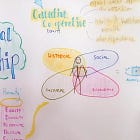




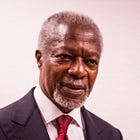
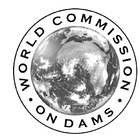



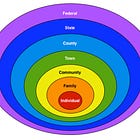






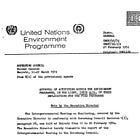
















![WHO Pandemic Agreement [April, 2024]](https://substackcdn.com/image/fetch/$s_!HHbL!,w_140,h_140,c_fill,f_auto,q_auto:good,fl_progressive:steep,g_auto/https%3A%2F%2Fsubstack-post-media.s3.amazonaws.com%2Fpublic%2Fimages%2Fb69c8066-0498-4924-af63-1344abb2ec85_1206x612.png)





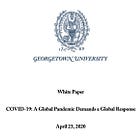











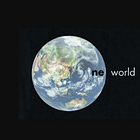
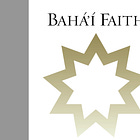



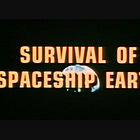
As usual, an excellent chronological and integrated summary of not well-known but important events. Would be grateful for the page or exact quotations for your references to The Communist Manifesto here: ...."a strategy that could see the power of money creation gradualy transferred entirely to the central bank, logically fulfilling a prerequisite set by Marx and Engels in the Communist Manifesto." And again a quote from yours above: ...'the violent revolution championed by Marx and Engels.'
My question is who is paying for all this shit? Of course it's the very rich but why? That's easy to answer. It's freedom for the elite and communism for everyone else. 1984.